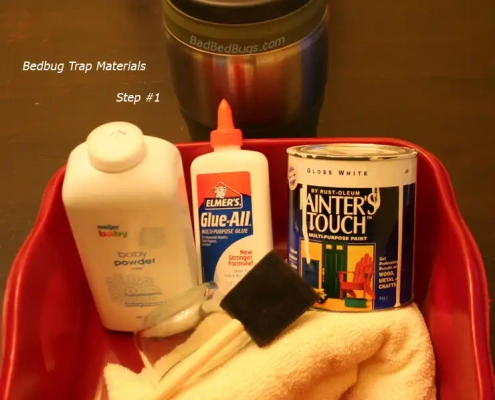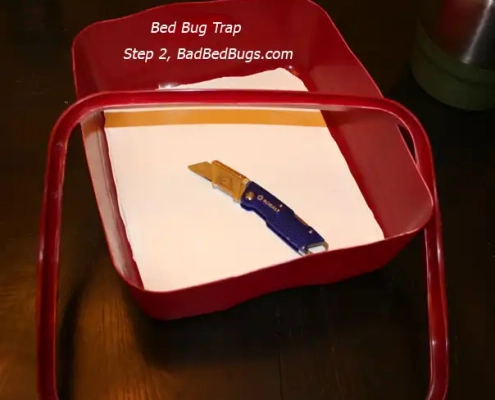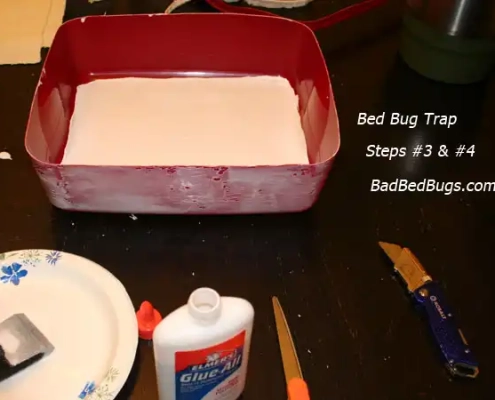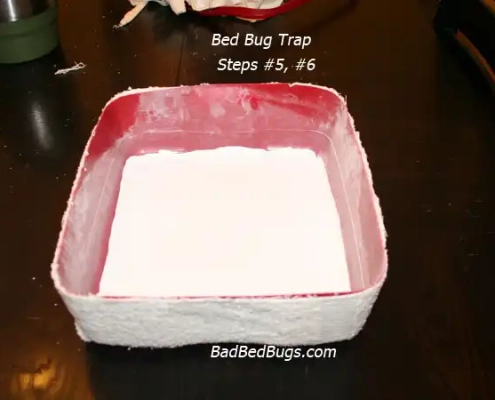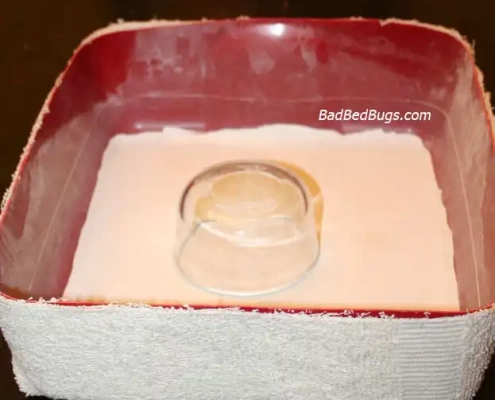How to Build the Bed Bug Trap
- Paint the bottom of the litter box white (I used white gloss) so that the trapped bugs are easy to identify. I used fast-drying paint and a hairdryer to speed up the process.
- Once the paint has dried, cut the top of the box off so that the edges are straight. My top had a lip that would have made it difficult for the bed bugs to climb inside.
- With my $1 towel, I cut sections that would fit on the outside of the box and glued them in place, taking care not to leave any gaps between the cloth and side where the bugs could hide. Ensure the fabric goes the entire length of the side so that as you lay the trap on the floor, it touches the carpet (or wood, etc.); this makes it easy for the bed bugs to climb up the side.
- Once you have glued the cloth on, apply a light dusting of baby powder to the bottom and insides of the trap. Also, use a light coating on your glass bowl. The small bowl will sit inside the trap, acting as a base for your thermos and preventing the bed bugs from climbing up the thermos.
- This next part can be dangerous as dry ice can severely burn your skin; use thick insulated gloves, grill thongs, or pliers to handle the ice. Placing dry ice in a sealed container without ventilation will cause pressure to build until the top blows. Dry ice releases carbon dioxide, which could cause asphyxia, so only use one of these traps per average-sized room. A 1/3 gallon bug trap is said to be the equivalent of two adults sleeping. Keep away from children.
To test your trap, place some dry ice in the thermos, add a quarter cup of water, close the lid and lean the spout angle to determine levels (closed, partway, or completely open).
The final step is to place the dry ice in the empty thermos, screw on the cap, open the spot halfway, and place it on the glass base inside the litter box around 10:00 pm. Finally, set the bed bug trap next to the bed.
Note: if the spout directs the CO2 away from your trap, you can hang a piece of paper over the spout to redirect the flow downward and into the trap (without blocking the spout).
In the morning, you’ll see any bed bugs caught at night. You should set the trap multiple times over two weeks. NOTE: If you move this trap to another room, make sure to seal it in a plastic bag and freeze it to make sure you don’t accidentally transport the bugs to another room!
Trap w Alka-Seltzer®
Did you know that Alka-Seltzer, when placed in water, creates Carbon Dioxide (CO2)? Yup, those bubbles are filled with it, and it’s the same stuff that tells bed bugs food is on the table (that being you!).
You’ll need a plastic litter box and materials used to finish the box (shown in the image used for the Dry Ice trap), a wet sponge, disposable hand warmers, a plate, and 4 Alka-Seltzer tablets, and DE. Make the box as shown in the image above. Activate the hand warmer and place it in the center of the plate. Place the wet sponge on the hand warmer and then the tablets spaced evenly on the sponge. Now take the plate and everything that’s on it and place it inside the box.
The moisture in the sponge will keep the Alka-Seltzer reaction active and continually release CO2; this should be enough to attract any bed bugs in hiding close to the trap. Once they are in the trap, they will be unable to leave, and you’ll have confirmation of an infestation.
Note: Placing the tablets in room temperature water will cause the CO2 to release much faster but won’t last nearly as long (you need to give them time).
I’ve Trapped Bed Bugs, Now What?
When you have captured the bugs, please, take a picture and anonymously share it with others! Simply upload your pictures here (click and select your images, fast and easy).
If you are sure you’ve caught bed bugs, then learn how to get rid of them without spending a fortune on an exterminator.
I want to thank Dr. Changlu Wang, an entomologist from Rutgers University who came up with the idea of using dry ice to trap bed bugs, and Richard Fagerlund, a board-certified entomologist at the University of New Mexico, for covering the use of Alka-Seltzer in traps.

